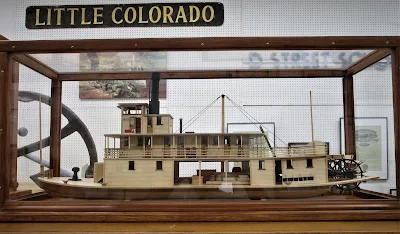 |
| A wonderfully sad tale of hope and despair |
 |
| Welcome to Needles - the starting point on Route 66 in California |
Being a Steinbeck fan, I knew there was much to explore in the city of Needles. Of course, we had passed by the city a million times while traveling along Interstate 40, but never had taken the time to stop and really look around.
That small city of Needles hugs the western shore of the Colorado River. It’s a peaceful town with a long and rich history. A short drive along Route 66 to the center of town, can easily let the visitor know that this town needs to be explored.
And explore we did.
Steinbeck had been correct with his musings. Needles is truly a pretty town and with such an eclectic history, it draws visitors from around the world.
According to the president of the Needles Regional Museum, Marianne Jones, “I would say we receive over three thousand visitors each year to our museum from all over the world. People are fascinated with the lore of Route 66. We get people from China, France, New Zealand, Ukraine, and from anywhere imaginable. As a matter of fact, most of our visitors are from Germany.”
It is the city where Charles Schulz, of Peanuts fame, spent part of his childhood – thus the reason why Snoopy’s brother, Spike, resides in Needles. This lovely little burg is also where Bess Houdini, the wife of the internationally famous magician, passed away in 1943. Alice Notley, a 1999 finalist for the Pulitzer Prize in poetry, grew up here. Oh, this town has seen it all.
 |
| Charles Schulz - spent a part of his childhood in Needles |
 |
| And Spike is glad - he loves Needles |
Soon, the tent city turned into a permanent settlement, with Needles being the largest river port north of Yuma. Yes, a port city. This is before the dams were built further north along the Colorado River, shrinking the flow and thus negating the need for paddle wheels and barges which had plied the crystal blue waters.
 |
| Model of a paddle-wheeler that plied the Colorado River near Needles |
Harvey House? Sounded like a frat house. Nope.
Fred Harvey, was a genius when it came to taking an idea and turning it to fruition. With the development of the railroad, the entrepreneur decided there was a need for high class food and service along the railway lines. He opened his first restaurant in Florence, Kansas in 1878 and expanded westward. Harvey is considered by many, to be the creator of the concept of chain restaurants and by the late 1880’s, there was a Fred Harvey dining experience every 100 miles or so along the Santa Fe railroad line.
 |
| The man himself, Fred Harvey |
Needles happens to be home to one of the most luxurious depots that houses a Harvey House – the original depot burned down in 1907, but when rebuilt, the railroad spared no expense to reconstruct the masterpiece the following year. The two story structure was named after Father Francisco Garces, who in 1776, traveled through the Mojave Desert and became known as the first European to make such a venture. The El Garces is a short walk from the Needles Regional Museum and is definitely worth the steps.
 |
| The Harvey House was located within the beautiful, El Garces building |
Turns out though it’s rather simple. There are a group of large sharply pointed pinnacles just southeast of the current city of Needles, on the Arizona side of the border, stretching skyward.
“It’s funny,” Jones mused. “Our name comes from across the river, in Arizona, yet we’re in California. Oh well, the name stuck and we like it.”
She also mentioned that most travelers believe that Route 66 is one block south, but is actually on Front Street. “They realigned the streets, we are on the actual original route.”
The entire town is worth a visit for anyone interested in Route 66 lore, early California history, the railroad, and so much more. Laureen and I only spent a few hours but know we will return to continue to investigate and explore.
Needles offers many exciting events every year keeping the rich history of the town alive. On March 13th, Laura Tohe, the daughter of a Navajo code talker will be discussing her father’s involvement in this highly secretive but critically important job during World War II.
We plan on visiting – perhaps you should too.
 |
| And bring the pets, Needles is a dog friendly town |
http://needlesregionalmuseum.org/











